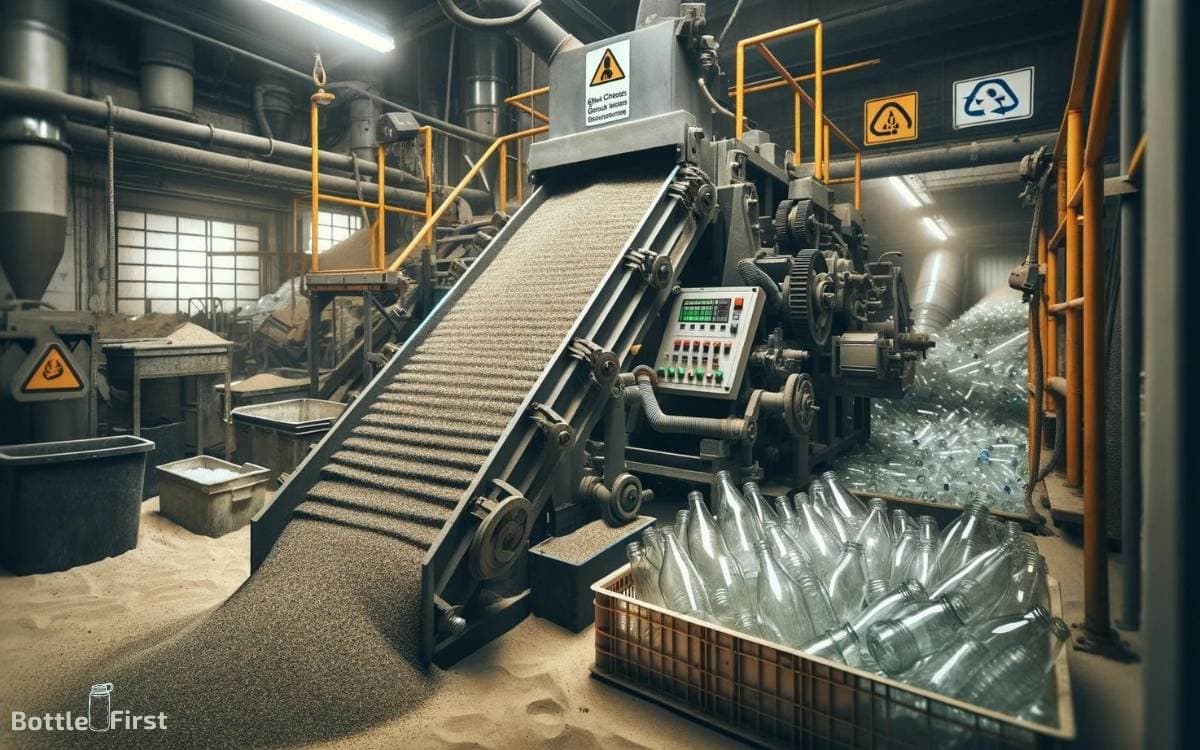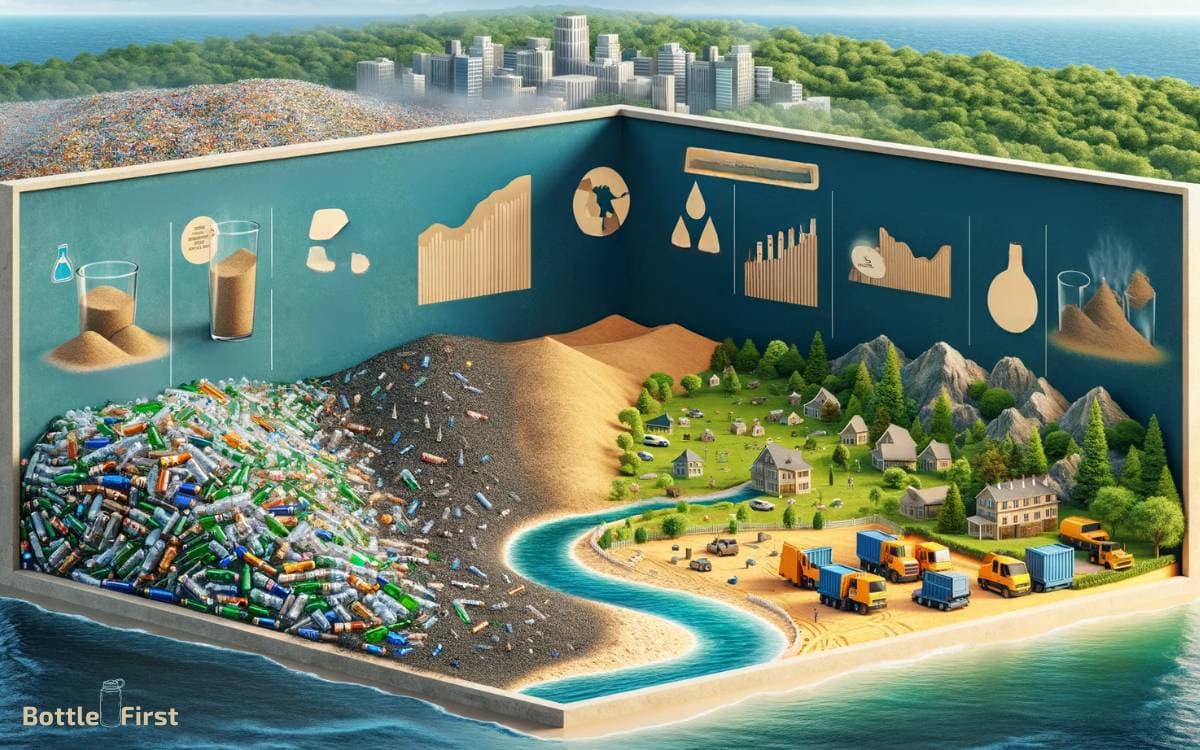How to Turn Glass Bottles into Sand? 6 Easy Steps!
Turning glass bottles into sand is a transformative recycling process. With the right equipment, such as a glass crusher, these bottles can be crushed into fine sand, offering an eco-friendly alternative to traditional sand.
This process is both sustainable and creates valuable resources.
Here are some quick steps:
For example, some restaurants use small glass crushers to turn their wine bottles into sand, which is then used in place of commercial sand in various applications.
Transforming glass bottles into sand not only conserves natural resources but also opens up a realm of eco-friendly possibilities.
Key Takeaway
Step 1: Collecting Empty Glass Bottles
To start turning glass bottles into sand, you’ll need to begin by collecting empty glass bottles from your local community and your own household.
Look for local recycling centers, bars, restaurants, and event venues that may be willing to give away their empty glass bottles.
You can also encourage your friends, family, and neighbors to save their empty glass bottles for this purpose.
Additionally, consider organizing a bottle collection drive in your community to gather a large quantity of bottles.
To make the process more efficient, set up designated collection points where people can easily drop off their empty glass bottles.
Step 2: Preparing the Glass Bottles for Crushing
First, carefully remove the labels from the glass bottles using a scraper or adhesive remover.
Make sure the bottles are thoroughly cleaned to remove any remaining residue or dirt. This will ensure that the bottles are ready for the crushing process and will produce high-quality sand.
Removing Bottle Labels Efficiently
Start by soaking the glass bottles in warm, soapy water to efficiently remove the labels before crushing them into sand. This method allows for easy removal of labels, ensuring a smoother transformation process.
Here are some tips to help you remove bottle labels efficiently:
- Patience: Soaking the bottles for at least 30 minutes will loosen the labels, making them easier to peel off.
- Gentle Scrubbing: Use a sponge or cloth to gently scrub off any remaining label residue.
- Hot Water Rinse: After soaking, rinse the bottles with hot water to wash away any adhesive or paper remnants.
Ensuring Bottles Are Clean
After removing the labels, ensure the glass bottles are thoroughly clean to prepare them for crushing into sand.
To guarantee the bottles are free from any contaminants, follow these simple steps:
| Step | Instructions |
|---|---|
| 1. | Rinse the bottles with hot, soapy water to remove any remaining residues. |
| 2. | Use a bottle brush to scrub the interior walls and bottom of the bottles. |
| 3. | Rinse the bottles again with clean water to remove all soap and debris. |
| 4. | Air dry the bottles upside down on a clean towel or rack to ensure no moisture is trapped inside. |
By following these steps, you’ll ensure that the glass bottles are clean and ready for the crushing process, allowing for efficient conversion into sand.
Step 3: Crushing the Glass Bottles Into Sand
Now it’s time to crush the glass bottles into sand, creating an eco-friendly reuse for the material.
This sand can be used for construction purposes, providing a sustainable alternative to traditional sand.
Crushing for Eco-Friendly Reuse
You can crush glass bottles into sand using a glass crushing machine.
It’s a simple and effective process that offers numerous benefits, such as:
- Environmental Impact: By converting glass bottles into sand, you’re contributing to a sustainable and eco-friendly solution for glass waste.
- Resource Conservation: Crushing glass into sand helps conserve natural resources by reducing the need for mining and extraction of sand from rivers and beaches.
- Community Engagement: This process can also engage local communities in environmental initiatives, fostering a sense of responsibility and pride in creating a positive impact.
With the innovative approach of converting glass bottles into sand, we can now explore the use of this eco-friendly material in construction and other applications.
Sand for Construction Materials
To use the sand created from crushing glass bottles for construction materials, you can employ it as a sustainable alternative in various building applications.
This glass-derived sand can be used in concrete production, reducing the need for natural sand and lowering the environmental impact of construction.
It can also be utilized as a base material for laying bricks, pavers, and pathways, offering a greener option for these projects.
Additionally, the finely crushed glass can be mixed with asphalt to create durable and eco-friendly road surfaces.
By incorporating this sand into construction materials, you not only reduce the demand for natural resources but also contribute to the circular economy by repurposing glass waste.
Embracing this innovative approach can lead to more sustainable and environmentally conscious construction practices.
Glass Bottle Recycling Benefits
By crushing glass bottles into sand, you can significantly reduce waste and contribute to sustainable recycling practices.
This innovative approach to glass bottle recycling offers numerous benefits, evoking a sense of responsibility and pride in your environmental impact:
Environmental Impact:
- Reducing landfill waste and pollution.
- Conserving natural resources and energy by reusing glass.
Economic Benefits:
- Creating new opportunities for businesses and industries to utilize recycled glass sand.
- Potentially reducing the need for raw materials, leading to cost savings.
Social Responsibility:
- Demonstrating a commitment to environmental stewardship.
- Encouraging others to adopt eco-friendly practices for a better future.
Crushing glass bottles into sand not only provides a practical solution to waste management but also aligns with the growing demand for sustainable and innovative recycling methods.
Step 4: Sieving and Sorting the Crushed Glass
After crushing the glass bottles into sand, start sieving and sorting the crushed glass to remove any remaining debris and particles.
This process ensures that the sand produced is clean and free of impurities, making it suitable for various applications.
Use a sieve with a mesh size that allows the desired sand particle size to pass through while retaining larger particles.
Here’s a simple guide to help you sieve and sort the crushed glass effectively:
| Step | Action |
|---|---|
| 1. Prepare Equipment | Set up a sieve and collection container. |
| 2. Pour the Sand | Pour the crushed glass sand onto the sieve. |
| 3. Sieve the Sand | Gently shake or tap the sieve to separate the particles. |
| 4. Discard Debris | Remove any remaining debris or particles from the sieve. |
| 5. Collect the Sand | Collect the sieved glass sand in the container for use. |
Step 5: Utilizing the Glass Sand for Various Applications
Using the sieved glass sand for various applications involves considering its particle size and purity. Once you have the right sand, the possibilities are endless.
Consider the following:
- Eco-friendly Construction: Utilize the glass sand in concrete mixtures for sustainable construction, reducing the demand for natural sand and decreasing the carbon footprint.
- Artistic Creations: Embrace the unique texture of glass sand in art and decor, adding a touch of innovation and sustainability to your creative projects.
- Green Landscaping: Enhance your outdoor spaces by incorporating glass sand into landscaping designs, providing a visually appealing and environmentally conscious alternative to traditional materials.
With the right approach, the glass sand opens up a world of eco-friendly and innovative possibilities for various applications.
Step 6: Environmental Benefits of Glass Bottle Recycling
You can reap significant environmental benefits by repurposing glass bottles through recycling. By recycling glass bottles, you contribute to reducing the amount of waste in landfills and the energy required to produce new glass.
This process helps conserve natural resources such as sand, soda ash, and limestone, which are the primary components of glass.
Additionally, glass is 100% recyclable, meaning it can be recycled endlessly without losing its quality or purity.
By participating in glass bottle recycling, you can lower carbon emissions and decrease the environmental impact of glass production.
This sustainable practice also helps in conserving energy, as melting recycled glass requires less energy compared to producing new glass from raw materials.
Embracing glass bottle recycling is a proactive step towards a cleaner, more sustainable environment.
Conclusion
Now that you’ve turned those empty glass bottles into sand, imagine the endless possibilities. From creating beautiful art projects to building sustainable structures, the glass sand can be used in so many ways.
And the best part? You’ve also helped to reduce waste and protect the environment.
Keep up the great work and continue finding creative ways to repurpose materials for a better, cleaner world.







